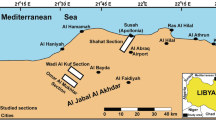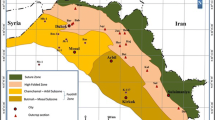Abstract
The carbonate–evaporite mixed Asmari Formation was investigated on the three representative outcrops (these of Zarrin-abad, Abhar, and Darreh-shahr, corresponding to three sections) of the Lurestan Zone in NW Zagros, where the sedimentary facies of the Asmari Formation shows significant differences to those in other parts of Zagros. In the light of study results from the field observation and laboratory measurements, 16 facies have been recognized and differentiated, which are grouped into 5 facies associations, representing 6 sub-environments on a carbonate ramp. The sub-environments include peritidal area, lagoon, platform margin high-energy belts, middle ramp, outer ramp and evaporitic saltern. The evaporitic saltern points to such a condition, during which there occurred periodic change from carbonate to evaporitic settings. The alternation of carbonate with evaporitic settings appeared on a carbonate ramp connected with a hydrographically isolated intrashelf basin. The development of evaporite-dominated deposits of the Kalhur Member of Asmari Formation is related to the restriction of the basin during sea-level falls. This restriction led to succeeding evaporation of seawater and precipitation of evaporites. In times of sea-level rising, the basin was well reconnected to open ocean and thus the carbonate factory was reestablished over the basin. From sequence stratigraphic points of view, the formation is composed of two second-order regressive sequences, representing transitional conditions from deep-marine facies underlying Pabdeh Formation to shallow evaporitic facies overlying Gachsaran Formation. Each sequence is composed of a unit of evaporites at bottom displaying a falling-stage systems tract followed by thick carbonate strata, representing transgressive and highstand systems tracts. It is obvious that the major relative sea-level fall of the first second-order sequence was recorded by the facies development of the upper Kalhur gypsum of the Asmari Formation in the Zarrin-abad section, and there developed the paleokarst facies located at the sequence boundary in the Abhar, and Darreh-shahr sections.













Similar content being viewed by others
References
Adams TD (1969) The Asmari Formation of Lurestan and Khuzestan Provinces. Rep. # 1154, National Iranian Oil Company internal report (Unpub.)
Adams TD, Bourgeois F (1967) Asmari biostratigraphy. Geol. Explor. Div, IOOC Rep. # 1024, Tehran, National Iranian Oil Company internal report (Unpub.)
Ahr WM (2008) Geology of carbonate reservoirs: the identification, description, and characterization of hydrocarbon reservoirs in carbonate rocks. Wiley, Hoboken, New Jersey/Canada
Ala MA (1982) Chronology of trap formation and migration of hydrocarbons in Zagros sector of southwest Iran. AAPG Bull 66:1535–1541
Alavi M (1980) Tectonostratigraphic evolution of the Zagrosides of Iran. Geology 8:144–149
Alavi M (1991) Tectonic map of the Middle East: Tehran, Geological Survey of Iran, Scale: 1: 5,000,000
Alavi M (1994) Tectonics of the Zagros orogenic belt of Iran: new data and interpretations. Tectonophysics 229:211–238
Alavi M (2004) Regional stratigraphy of the Zagros fold-thrust belt of Iran and its proforeland evolution. Am J Sci 304:1–20
Alavi M (2007) Structures of the Zagros fold-thrust belt in Iran. Am J Sci 307:1064–1095
Amirshahkarami M, Vaziri-Moghaddam H, Taheri A (2007) Paleoenvironmental model and sequence stratigraphy of the Asmari Formation in southwest Iran. Hist Biol 19(2):173–183
Aqrawi AAM, Keramati M, Ehrenberg SN, Pickard N, Moallemi A, Svana T, Darke G, Dickson JAD, Oxtoby NH (2006) The origin of dolomite in the Asmari Formation (Oligocene–Lower Miocene), Dezful Embayment, SW Iran. J Pet Geol 29:381–402
Bahrami H (2000) Biostratigraphy and micropaleontological studies on the cutting samples of Changuleh well, north Dezful. Technical Report 1130. NIOCEXP Office Tehran (Unpub.)
Bahroudi A, Koyi HA (2004) Tectono-sedimentary framework of the Gachsaran Formation in the Zagros Foreland Basin. Mar Pet Geol 21:1295–1310
Berberian M, King GCP (1981) Towards a paleogeography and tectonic evolution of Iran. Can J Earth Sci 18:210–265
Beydoun ZR (1993) Evolution of the northeastern Arabian plate margin and shelf, hydrocarbon habitat and conceptual future potential. Revue de l’Institut Français du Pétrole 48:311–345
Beydoun ZR, Sikander AH (1992) The Red Sea- Gulf of Aden: re-assessment of hydrocarbon potential. Mar Pet Geol 9:475–485
Burchette TP, Wright VP (1992) Carbonate ramp depositional systems. Sed Geol 79:3–57
Buxton MWN, Pedley HM (1989) A standardized model for Tethyan Tertiary carbonates ramps. J Geol Soc 146:746–748
Dickson JAD (1965) A modified staining technique for carbonate in thin section. Nature 205:587
Dunham RJ (1962) Classification of carbonate rocks according to their depositional texture. In: Ham WE (ed) Classification of carbonate rocks, vol 1. AAPG Memoir, Tulsa, pp 108–121
Dunnington HV (1958) Generation, migration, accumulation and dissipation of oil in northern Iraq. Habitat of Oil, pp 1194–1251
Dunnington HV (1967) Stratigraphic distribution of oilfields in the Iraq-Iran- Arabia Basin. J Inst Pet 53:129–161
Ehrenberg SN, Pickard NAH, Laursen GV, Monibi S, Mossadegh ZK, Svana TA, Aqrawi AAM, McArthur JM, Thirlwall MF (2007) Strontium isotope stratigraphy of the Asmari Formation (Oligocene–Lower Miocene), SW Iran. J Pet Geol 30:107–128
Embry AF, Klovan JE (1971) A Late Devonian reef tract on northeastern Banks Island. N.W.T. Bull Can Pet Geol 19:730–781
Falcon NL (1958) Position of oilfields in South West Iran with respect to relevant sedimentary basins. In: Weeks LG (ed) Habitat of Oil, American Association of Petroleum Geologists Symposium, pp 1252–1278
Flügel E (2004) Microfacies analysis of limestones: analysis, interpretation and application. Springer, Berlin
Geel T (2000) Recognition of stratigraphic sequences in carbonate platform and slope deposits, empirical models based on microfacies analysis of Paleocene deposits in southeastern Spain. Palaeogeogr Palaeoclimatol Palaeoecol 155:211–238
Ghazban F (2007) Petroleum geology of the Persian Gulf. Tehran University and National Iranian Oil Company, Tehran, Iran
Henson FRS (1951) Observations on the geology and petroleum occurrences of the Middle East. In: Proceedings of the 3rd World Petroleum Congress, vol 1, pp 118–140
Heydari E (2008) Tectonics versus eustatic control on super sequences of the Zagros Mountains of Iran. Tectonophysics 451:56–70
Hunt D, Tucker ME (1992) Stranded parasequences and the forced regressive wedge systems tract: deposition during base level fall. Sed Geol 81:1–9
Hunt D, Tucker ME (1995) Stranded parasequences and the forced regressive wedge systems tract: deposition during base level fall—reply. Sed Geol 95:147–160
IOR (2006) Reservoir description of the Asmari Formation in the Dezful Embayment. National Iranian Oil Company internal report (unpublished)
James NP, Choquette PW (1984) Diagenesis 9. Limestones—the meteoric diagenetic environment. Geosci Can 11:161–194
James GA, Wynd JG (1965) Stratigraphic nomenclature of Iranian oil consortium agreement area. AAPG Bull 49:2182–2245
Kashfi MS (1984) A source bed study of the Oligo-Miocene Asmari Limestone in SW Iran. J Pet Geol 7(4):419–428
Kavoosi MA, Sherkati Sh (2012) Depositional environments of the Kalhur Member evaporites and tectonosedimentary evolution of the Zagros fold–thrust belt during Early Miocene in south westernmost of Iran. Carbonates Evaporites 27:55–69
Kendall AC (1992) Evaporites. In: Walker RG, James NP (eds) Facies models: response to sea level changes. Geological Association of Canada, Newfoundland
Koop WJ, Stoneley R (1982) Subsidence history of the Middle East Zagros Basin, Permian to Recent. Philos Trans R Soc Lond 305:149–168
McQuillan H (1974) Fracture patterns on Kuh-e-Asmari anticline, southwest Iran. AAPG Bull 58:236–246
Miall AD (2000) Principles of sedimentary basin analysis, 3rd edn. Springer, Berlin
Mosadegh ZK, Haig DW, Allan T, Adabi MH, Sadeghi A (2009) Salinity changes during Late Oligocene to Early Miocene Asmari Formation deposition, The Zagros Mountains, Iran. Palaeogeogr Palaeoclimatol Palaeoecol 272:17–36
Motiei H (1993) Stratigraphy of Zagros. Treatise on the Geology of Iran No. 1, Ministry of Mines and Metals. Geological Survey of Iran, Tehran (In Persian)
Murris RJ (1980) Middle East: stratigraphic evolution and oil habitat. AAPG Bull 64:597–618
Nayebi Z (2003) Biostratigraphy and micropaleontological studies on the cutting samples of Dalpari well, north Dezful. Paleontological note 580. NIOCEXP Office Tehran (Unpub.)
Pedley M (1998) A review of sediment distributions and processes in Oligo-Miocene ramps of southern Italy and Malta (Mediterranean divide). Geol Soc Lond Spec Publ 149:163–179
Pomar L (2001) Types of carbonate platforms: a genetic approach. Basin Res 13:313–334
Richardson RK (1924) The geology and oil measures of southwest Persia. J Inst Pet Technol 10:256–283
Sadeghi R, Vaziri-Moghaddam H, Taheri A (2009) Biostratigraphy and paleoecology of the Oligo-Miocene succession in Fars and Khuzestan areas (Zagros Basin, SW Iran). Hist Biol 20:1–15
Seyrafian A (2000) Microfacies and depositional environments of the Asmari Formation, at Dehdes area (A correlation across Central Zagros Basin). Carbonates Evaporites 15:22–48
Seyrafian A, Mojikhalifeh AR (2005) Biostratigraphy of the Late Paleogene-Early Neogene succession, north-central border of Persian Gulf, Iran. Carbonates Evaporites 20(1):91–97
Seyrafian A, Arzani N, Taheri A, Vaziri H, Hasheme M (2007) Facies analysis of Asmari Formation in the West/Northwest Zagros Heights. National Iranian Oil Company, internal report (Unpub.)
Sharland PR, Casey DM, Davies RB, Simmons MD, Sutcliffe OE (2004) Arabian Plate sequence stratigraphy. GeoArabia, vol 9, pp 121–124
Shearman DJ, Fuller JG (1969) Anhydrite diagenesis, calcitization, and organic laminites, Winnipegosis Formation, Middle Devonian, Saskatchewan. Bull Can Pet Geol 17(4):496
Stocklin J (1974) A-Northern Iran: Alborz Mountains, Mesozoic–Cenozoic orogenic Belt, data for orogenic studies. Geol Soc Lond Spec Publ 4:213–234
Takin M (1972) Iranian geology and continental drift in the Middle East. Nature 235:147–150
Thomas AN (1951) The Asmari Limestone of southwest Iran. National Iranian Oil Company internal Report 706 (unpublished)
Thomas AN (1952) Facies variations in the Asmari Formation. Report of the 18th International Geological Congress (Great Britain), Part 10: 74–82
Tucker ME (1991) Sequence stratigraphy of carbonate–evaporite basins: models and application to the Upper Permian (Zechstein) of northeast England and adjoining North Sea. J Geol Soc Lond 148:1019–1036
Tucker ME, Wright VP (1990) Carbonate sedimentology. Blackwell Scientific Publications, Oxford
Tucker ME, Calvet F, Hunt D (1993) Sequence stratigraphy of carbonate ramps: systems tracts, models and application to the Muschelkalk carbonate platforms of eastern Spain. In: Posamentier HW, Summerhayes CP, Haq BU, Allen GP (eds) Sequence Stratigraphy and Facies Associations. International Association of Sedimentologists, Special Publications, vol 18, pp 397–415
van Buchem FSP, Allan TL, Laursen GV, Lotfpour M, Moallemi A, Monibi S, Motiei H, Pickard NAH, Tahmasbi AR, Vedrenne V, Vincent B (2010) Regional stratigraphic architecture and reservoir types of the Oligo-Miocene deposits in the Dezful Embayment (Asmari and Pabdeh Formations) SW Iran. Geol Soc Lond Spec Publ 329(1):219–263
Vaziri-Moghaddam H, Kimiagari M, Taheri A (2006) Depositional environment and sequence stratigraphy of the Oligocene-Miocene Asmari Formation in SW Iran, Lali Area. Facies 52:41–51
Warren JK (1982) The hydrological setting, occurrence and significance of gypsum in late Quaternary salt lakes in South Australia. Sedimentology 29:609–637
Warren JK (1991) Sulfate-dominated sea-marginal and platform evaporative settings: sabkha and salina, mudflats and salterns. In: Melvin JL (ed) Evaporites, Petroleum and Mineral Resources. Developments in Sedimentology, vol 50. Elsevier, Amsterdam, pp 69–188
Warren JK (2006) Evaporites: sediments, resources and hydrocarbons. Springer, Berlin
Warren JK, Kendall GC (1985) Comparison of marine sabkha (sub aerial) and salina (subaqueous) evaporites: modern and ancient. AAPG Bull 69:1013–1023
Wells AJ (1967) Lithofacies and geological history of Lower Tertiary sediments in southwest Iran. IOOC, geological report # 1108
Wilson JL (1975) Carbonate facies in geological history. Springer, Berlin
Wynd J (1965) Biofacies of Iranian Oil Consortium Agreement Area. IOOC Report 1082 (Unpub.)
Zuffa GG (1985) Optical analyses of arenites: influence of methodology on compositional results. In: Zuffa GG (ed) Provenance of arenites. NATO-ASI, Series 148, D. Reidel, Dordrecht: 165–189
Acknowledgments
The University of Tehran provided facilities for this research, for which the authors are grateful. This study was financially supported by Iranian Central Oil Field Co (ICOFC). The authors would like to acknowledge the company for the support and permission to publish these results. Some data for this study is provided by H. Mohammadpour. Special thanks are expressed to M. Lankarani and M. R Tabarzadi for their help in the field studies and preparation of photographs, respectively. Esfandiar Mohammadpour is acknowledged for careful driving during the field studies.
Author information
Authors and Affiliations
Corresponding author
Rights and permissions
About this article
Cite this article
Daraei, M., Amini, A. & Ansari, M. Facies analysis and depositional environment study of the mixed carbonate–evaporite Asmari Formation (Oligo-Miocene) in the sequence stratigraphic framework, NW Zagros, Iran. Carbonates Evaporites 30, 253–272 (2015). https://doi.org/10.1007/s13146-014-0207-4
Accepted:
Published:
Issue Date:
DOI: https://doi.org/10.1007/s13146-014-0207-4




